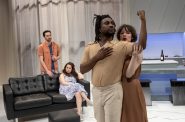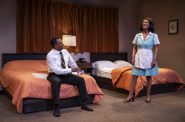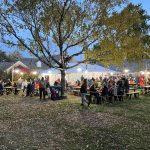Quicksilver Plays with Precision and Panache
Early Music Now concert captures the spirit of Baroque music back when it broke all the rules.
Friday and Saturday evening, Early Music Now hosted the string ensemble, Quicksilver for a pair of concerts featuring the Early Baroque at St. Paul’s Episcopal church. The pair began with “Stile Moderno: New Music from Seventeenth-Century Italy” on Friday evening. Quicksilver featured violinists and co-directors Robert Mealy and Julie Andrijeski, cellist David Morris, Charles Weaver on theorbo, and Avi Stein on harpsichord. This non-subscription concert on Friday evening was added in part to accommodate members of the American Musicological Society, in Milwaukee for their annual convention.
The political and economic stars were aligned for musical discovery in Italian city-states in the early 17th century. The explosion of ideas marked the end of the extraordinarily beautiful but conservative Renaissance period of music. Early Baroque music was marked by turning away from rigid rules for composition and introducing music that was unpredictable, even quirky. Music written for instrumental ensembles featured individual virtuoso performers. The “modern style” tapped emotional content and dramatic contrasts. The concert program notes describe the “new invention, the sonata ..with no agenda but the imagination of the composer .. (and) no standard formal shape except the passionate give-and-take of friends in conversation.”
A Sonata prima by Dario Castello featured violinist Andrijeski accompanied only by theorbo and harpsichord. Her violin played at a fiddle’s pace in a work that evolved as a madrigal might, with theorbo and harpsichord commenting on the themes between highly virtuosic melodic riffs by the violin.
A Sonata a tre (sonata for three soloists) by Giovanni Paolo Cima represented another innovation – a lively conversation between the two violins and cellist Morris. They shared an imitative theme that would evolve into fugal structures in later works.
A Ciaconna by Tarquino Merula featured an infectious melody by the bass instruments – cello, theobo and harpsichord. As that dance rhythm repeated again and again, violinists Mealy and Andrijeski exchanged virtuoso roles in a conversation that seemed designed to show off the “new” violin’s capabilities. With gut strings, the Baroque violin does not have the penetrating sound of contemporary instruments. And the ensemble chose to balance the ciaconna (chaconne) rhythm with the conversing violins rather than call attention to either. Despite the radical character of the “new music”, Quicksilver seemed to adopt a conservative, explicitly accurate approach to presenting it.
Two toccatas featured solo instruments. Wikipedia defines the Toccata as “(from Italian toccare, to touch) – a virtuoso piece of music typically for a keyboard or plucked string instrument featuring fast-moving virtuosic passages generally emphasizing the dexterity of the performer’s fingers.” The Toccata by Giovanni Girolamo Kapsberger featured Weaver on theorbo. The theorbo is a basically a lute on steroids – with four very long bass strings added which require a very extended neck on the instrument. This range allowed Weaver to contrast high and low range notes foreshadowing the later “two-voice” techniques of Bach partitas.
The Quicksilver ensemble are clear masters of the repertory they presented. They offered a master class in a short, but exciting era in Western classical music history. They played with great precision and panache – conveying the energy and improvisatory style of the composers. The ensemble’s playing was enhanced by the acoustical space in the sanctuary of St. Paul’s church which further blended the sound, but without distortion, before sending it to the audience.
Early Music Now will next present Lionheart (New York) in a concert “Laude: Joy and Mystery” on both December 13 (Sa) at 5:00 PM & December 14 (Su) at 3:00 PM at St. Joseph Center Chapel (1501 S Layton Blvd). For further information, including complete performer details and program notes, see the Early Music Now website. www.earlymusicnow.org Tickets may be purchased on-line or at 414-225-3113. Tickets are $28 – $44, but $10 – $15 for students. Parking is available in the lot south of the convent building housing the chapel.
Review
-
‘L’Appartement’ Is a Mind-Bending Comedy
 Mar 25th, 2024 by Dominique Paul Noth
Mar 25th, 2024 by Dominique Paul Noth
-
Highlands Café Is Easy to Love
 Mar 15th, 2024 by Cari Taylor-Carlson
Mar 15th, 2024 by Cari Taylor-Carlson
-
‘The Mountaintop’ Offers Very Human Martin Luther King Jr.
 Mar 11th, 2024 by Dominique Paul Noth
Mar 11th, 2024 by Dominique Paul Noth















